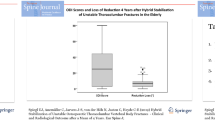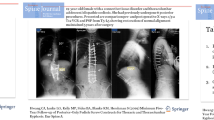Abstract
Introduction
The posterior transpedicular fixation technique is a standard procedure for stabilizing the injured thoracolumbar spine but the long-term results of this approach are controversial. Clear guidelines are missing and the literature shows complete disagreement regarding indications, approaches, surgical techniques, and type of fixation.
Material and method
The objective of this study is to investigate if the surgical treatment by posterior approach alone is always enough to prevent the late kyphotic deformity through the retrospective analysis of 219 patients affected with a thoracolumbar injury. Follow-up examinations included radiographic measurements of the sagittal index (SI) and the sagittal plane kyphosis (SPK).
Result
Results show that, at the follow-up, the SI remains almost stable after the surgical correction, while the SPK (which describes the eventual injury of the affected intervertebral disc) decreases indicating a progressive regional kyphotic deformity. Thus, in some cases posterior fixation alone is not sufficient for long-term spinal stabilization and often can be not effective to prevent the late kyphotic deformity.






Similar content being viewed by others
References
Alanay A, Acaroglu E, Yazici M, Oznur A, Surat A (2001) Short segment pedicle instrumentation of thoracolumbar burst fractures: does transpedicular intracorporeal grafting prevent early failure? Spine 26:213–217
Andress HJ, Braun H, Helmberger T, Schürmann M, Hertlein H, Hartl WH (2002) Long-term results after posterior fixation of thoraco-lumbar burst fractures. Injury 33(4):357–365
Daniaux H (1986) Transpedicular repositioning and spongiosaplasty in fractures of the vertebral bodies of the lower thoracic and lumbar spine. Unfallchirurg 89:197–213
Daniaux H, Seykora P, Genelin A, Lang T, Kathrein A (1991) Application of posterior plating and modifications in thoracolumbar spine injuries: indication, technique and results. Spine 16(3 Suppl):S125–S133
Daniaux H, Wahner M, Kathrein A, Lang T (1999) Frakturen des thorakolumbalen Ubergangs. Die conservative Behandlung. Orthopade 28:682–691
Denis F, Armstrong GWD, Searls K et al (1984) Acute thoracolumbar burst fractures in the absence of neurologic deficit. Clin Orthop 189:142–149
Farcy JP, Veidenbaum M (1988) A preliminary review of the use of Cotrel–Dubousset instrumentation for spinal injuries. Bull Jt Dis Orthop Ins 48:44–51
Farcy JP, Veidenbaum M, Glassman S (1990) Sagittal index in management of thoracolumbar burst fractures. Spine 15:958–965
Gertzbein SD, Scoliosis Research Society (1992) Multicenter spine fracture study. Spine 17:528–539
Knop C, Blauth M, Bühren V, Hax PM et al (1999) Operative Behandlung von Verletzungen des thorakolumbalen Übergangs: Teil 1 “Epidemiologie”. Unfallchirurg 102(12):924–935
Knop C, Blauth M, Bühren V, Hax PM et al (2000) Operative Behandlung von Verletzungen des thorakolumbalen Übergangs: Teil 2 “Operation und Radiologie”. Unfallchirurg 103:1032–1047
Knop C, Fabian HF, Bastian L, Blauth M (2001) Late results of thoracolumbar fractures after posterior instrumentation and transpedicular bone grafting. Spine 26(1):88–99
Knop C, Blauth M, Buhren V, Arand M et al (2001) Operative Behandlung von Verletzungen des thorakolumbalen Überganges—Teil 3: nachuntersuchung. Unfallchirurg 104(7):583–600
Kuklo TR, Polly DW, Owens BD, Zeidman SM, Chang AS, Klemme WR (2001) Measurement of thoracic and lumbar fracture kyphosis: evaluation of intra observer, inter observer, and technique variability. Spine 26(1):61–65
Lee YS, Sung JK (2005) Long-term follow-up results of short-segment. Posterior screw fixation for thoracolumbar burst fractures. J Kor Neurosurg Soc 37:416–421
Leferink VJ, Zimmerman KW, Veldhuis EF (2001) Thoracolumbar spinal fractures: radiological results of transpedicular fixation combined with transpedicular cancellous bone graft and posterior fusion in 183 patients. Eur spine J 10:517–523
Magerl F, Aebi M, Gertzbein SD, Harms J, Nazarian S (1994) A comprehensive classification of thoracic and lumbar injuries. Eur Spine J 3(4):184–201
Muller U, Berlemann U, Sledge J et al (1999) Treatment of thoracolumbar burst fractures without neurologic deficit by indirect reduction and posterior instrumentation: bi-segmental stabilization with mono-segmental fusion. Eur Spine J 8:284–289
Patrick T, Russel CH, Christian AL, Dominique GP, Rene PL (2003) Functional and radiologic outcome of thoracolumbar and burst fractures managed by closed orthopedic reduction and casting. Spine 28:2459–2465
Sandreson PL, Fraser RD, Hall DJ, Cain CM, Osti OL, Potter GR (1999) Short segment fixation of thoracolumbar burst fractures without fusion. Eur Spine J 8:495–500
Stambough JL (1997) Posterior instrumentation for thoracolumbar trauma. Clin Orthop 335:73–88
Shin TS, Kim HW, Park KS, Kim JM, Jung CK (2007) Short-segment pedicle instrumentation of thoracolumbar burst-compression fractures; short term follow-up results. J Kor Neurosurg Soc 42(4):65–70
Weidenbaum M, Farcy JPC (1997) Surgical management of thoracic and lumbar burst fractures. In: Bridwell KH, Gordon RL (eds) The textbook of spinal surgery. Lippincott-Raven, New York, p 1851
Wang XY, Dai LY, Xu HZ, Chi YL (2008) Kyphosis recurrence after posterior short-segment fixation in thoracolumbar burst fractures. J Neurosurg Spine 8(3):246–254
Conflict of interest
None.
Author information
Authors and Affiliations
Corresponding author
Rights and permissions
About this article
Cite this article
Martiniani, M., Vanacore, F., Meco, L. et al. Is posterior fixation alone effective to prevent the late kyphosis after T-L fracture?. Eur Spine J 22 (Suppl 6), 951–956 (2013). https://doi.org/10.1007/s00586-013-3008-x
Received:
Revised:
Accepted:
Published:
Issue Date:
DOI: https://doi.org/10.1007/s00586-013-3008-x




